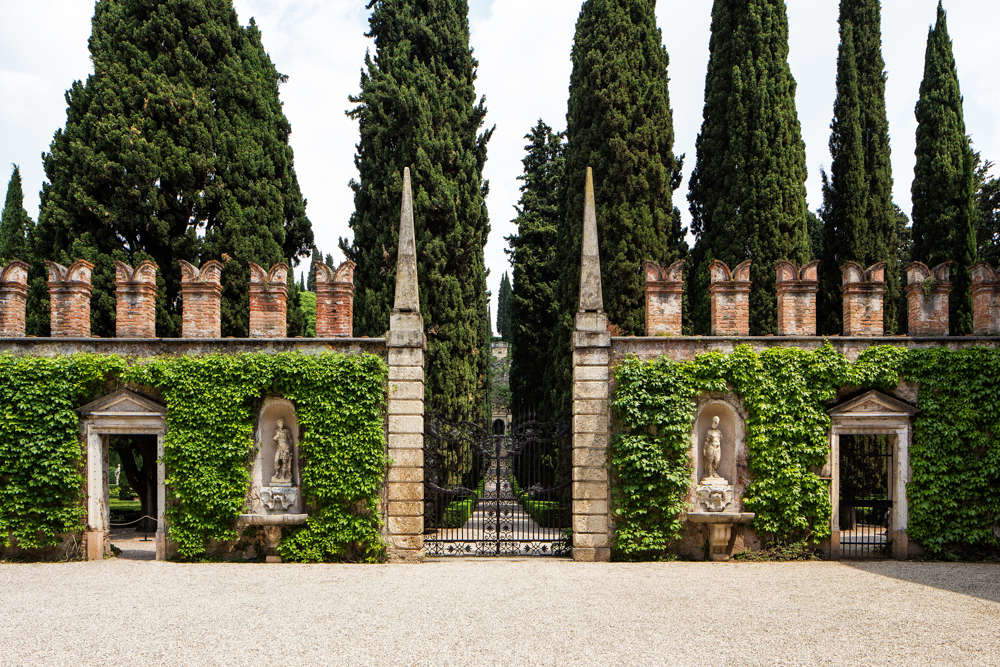Exploring the concept of the labyrinth involves an immersion in something ancestral and, perhaps, as ancient as the very fabric of human history itself. It means approaching a symbol that has presumably kept steadfast company with humankind since its earliest days, and to which a multiplicity of meanings are attributed today. Although multiple interpretive efforts have been undertaken, theetymology of the word “labyrinth” remains, unfortunately, shrouded in obscurity, but perhaps it was the inherent guise of the labyrinth, so elusive and extremely ambiguous, that attracted the diplomat Agostino Giusti (Verona, 1548 - 1615) during the 16th century, when he decided to have his personal maze created.
During the sixteenth century, the powerful Giusti family had a sumptuous palace and a spectacular Italian garden erected after moving to Verona from Tuscany in the late thirteenth century and entering the wool dyeing industry. This industry at the time constituted the main source of wealth for the city of Verona, and so in 1406 the head of the family Provolo Giusti managed to acquire a piece of land located near the ancient Via Postumia, which was the fundamental road link from east to west in the Po Valley.



In this area, along the ancient city walls, the family used the spaces of the present garden for two centuries, and they were for a long time dedicated to boiling cauldrons used for the treatment of wool and drying fabrics. During the 16th century, what was initially a manufacturing center was transformed, thanks mainly to Agostino Giusti, into a sumptuous palace of representation that followed the style of architect and urban planner Michele Sanmicheli. The wealthy Agostino was a cultured man with an immense passion for music and painting, and, no less important, he forged close relationships with the Medici and Habsburg families.
The former Giusti palace still maintains its status as a private residence and is not open to the public, although occasionally some of its rooms may host cultural events, while the garden often remains accessible from first light until dusk, becoming the undisputed star. Crossing the imposing entrance, manned by two majestic obelisks, one finds oneself immersed in a long avenue of centuries-old cypresses that leads from the palace to the hill of San Zeno. It was of these very cypresses that the distinguished French encyclopedist, anthropologist Charles de Brosses, Count of Tournay, wrote in his epistolary diary of his trip to Italy between 1739 and 1740, and described them as “incredibly tall and pointed, planted throughout the garden, they give the place the appearance of one of those places where magicians hold the Sabbath.” And it is at the entrance to the garden that the most imposing cypress, also known as the “Goethe Cypress,” stands out. A tree, this one, reaching 25 meters in height and a circumference of 4 meters, which would suggest an age of more than 500 years. The elderly shrub was named after the German poet because of a rather unique legend: it is said, in fact, that when the young man lived in the palace he heard the story that the green foliage of the cypress gave fertility. Goethe believed so much in this ancient tradition that he collected and preserved some of the tree’s twigs, hoping they were effective amulets for male virility.
At the end of the enchanted avenue of cypress trees, stands a knoll with a grotto topped by a large stone monstrous mask, similar to the one found in Bomarzo’s Monster Park, crowned by a belvedere terrace that was used by diplomat and patron Agostino Giusti to impress guests by spewing tongues of fire from its nostrils and jaws.

 The labyrinth of the
The labyrinth of the
The grotto, moreover, was designed to disturb visitors with mirrors and echoes of roaring water, but it was the arboreal boxwood labyrinth that was the real “trap” of the garden. Fifteenth- and seventeenth-century arboreal mazes have their roots in the gardens of medieval convents and castles, as evidenced by various literary sources. This practice, seemingly unusual for the stereotypes of the time, may derive from Eastern, Byzantine and Arab influences, and represents an evolution of convent gardens and herbaria. Contrary to the common image of truculent warriors, medieval men also devoted themselves to decorating their dwellings with these garden-labyrinths, creating complex and intriguing spaces. The wealthy patron Agostino Giusti was enamored with anything that was pleasing to the eye, but above all entertaining, and although the hedges of his labyrinth were never so high as to engulf the visitor in a world of lush foliage, it was extremely difficult and at times almost impossible to find his way out. Inside, in fact, even the encyclopedist Charles de Brosses became trapped, wandering for hours in a desperate search for the exit.
Unfortunately, to this day we do not receive Agostino Giusti’s 16th-century original, but a 1786 specimen designed by Luigi Trezza, with an eight-order square plan, similar to that of the labyrinths in Roman mosaics, which diligently preserves the atmosphere of the original garden that is nevertheless considered one of only three surviving historical labyrinths in all of Italy.
 |
| An ancient maze in the center of Verona: the Labyrinth of the Giusti Garden |
Warning: the translation into English of the original Italian article was created using automatic tools. We undertake to review all articles, but we do not guarantee the total absence of inaccuracies in the translation due to the program. You can find the original by clicking on the ITA button. If you find any mistake,please contact us.